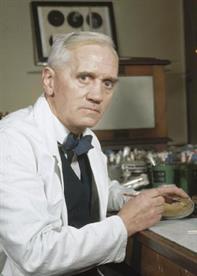PDF chapter test TRY NOW
Antibiotics
Antibiotic is asubstance, which is synthesised from microorganisms and plants, that kills the bacteria and cures infections, but it is not effective against viral infections such as cold, dry cough, sore throat, etc.
Many years ago, even a small infected wound caused death. Invention of antibiotics changed this situation. In 1928, Dr Alexander Fleming, British bacteriologist, was on the research of staphylococcus bacteria, which caused the deadly diseases like pneumonia, sore throat, etc. He had been culturing the bacteria on the nutrient agar media in a petri dish.
During the research, he left the laboratory for a holiday, leaving the dish carelessly on the table without cleaning and sterilising. When he was back after several days, he found that the growth of the mould (type of ordinary fungus, which grows on stale bread/cheese) on the petri dish.
During the research, he left the laboratory for a holiday, leaving the dish carelessly on the table without cleaning and sterilising. When he was back after several days, he found that the growth of the mould (type of ordinary fungus, which grows on stale bread/cheese) on the petri dish.
In addition, he noticed that there was no bacterial growth around the mould. The mould showed something present in it which halted the growth of the bacteria. On continuous research, he found that mould juice was able to destroy a wide variety of bacteria (streptococcus, meningococcus and diphtheria bacillus). That is how the world's first antibiotic (penicillin) was found.
Mould penicillium notatum was named by Fleming. From that, the antibiotic penicillin was isolated.
Ten decades ago, Egyptians had used mouldy bread to cure infected wounds. Not only Egyptians but also ancient Greeks, Serbians and Indians also used the mould. This implies that Fleming was not the first person using moulds and other living microorganisms for curing infected wounds.
Due to so many advancements in the research on the antibiotic, nowadays, infectious diseases are very less.

Dr Alexander Fleming
Example:
- Chloramphenicol
- Tetracyclines
- Penicillin derivatives
- Cephalosporin’s and their derivatives
Side effects:
Antibiotics give side effects mostly in the digestive part. It may occur in less number of people (For example, 10 out of 100 people).
- Nausea
- Vomiting
- Pain in abdominal
- Appetite loss
Drawback:
When we take limitless antibiotics for long term, they become inactive or significantly less reactive. Instead, we would be supposed to take a larger dose or move towards the use of other virulent variants of antibiotics.
